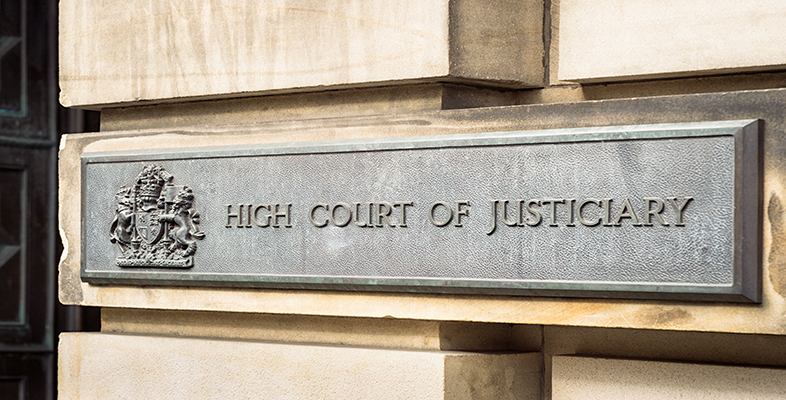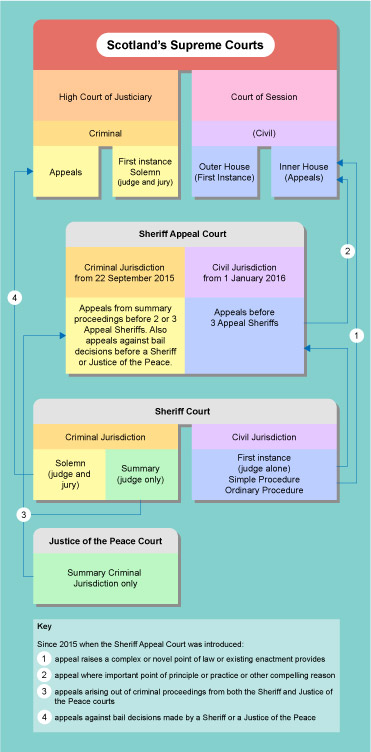1.2 Scottish civil court structure
Figure 2 illustrates the court structure in Scotland. The arrows indicate the routes of appeal which exist. If certain criteria are met it is sometimes possible to appeal the decision made in one court to another court.
1. The Court of Session
The Court of Session, Scotland's supreme civil court, sits in Parliament House in Edinburgh as a court of first instance and a court of appeal.
The court is headed by the Lord President the second in rank being the Lord Justice Clerk.
The court is divided into the Outer House and the Inner House.
Outer House
The Outer House consists of 22 Lords Ordinary sitting alone or, in certain cases, with a civil jury. They hear cases at first instance on a wide range of civil matters, including cases based on delict (tort) and contract, commercial cases and judicial review. The judges cover a wide spectrum of work, but designated judges deal with intellectual property disputes. Special arrangements are made to deal with commercial cases. An appeal lies to the Supreme Court of the United Kingdom.
Inner House
The Inner House is in essence the appeal court, though it has a small range of first instance business. It is divided into the First and the Second Divisions, of equal authority, and presided over by the Lord President and the Lord Justice Clerk respectively. Each division is made up of six Judges, but the quorum is three. Due to pressure of business an Extra Division of three judges sits frequently nowadays. The Divisions hear cases on appeal from the Outer House, the Sheriff Court and certain tribunals and other bodies. On occasion, if a case is particularly important or difficult, or if it is necessary to overrule a previous binding authority, a larger court of five or more judges may be convened.
Cases can be presented by:
- An advocate - a member of the Faculty of Advocates whose status and function correspond to that of a barrister in England
- A solicitor-advocate - a. member of the Law Society of Scotland. Experienced solicitors who obtain an extension of their rights of audience by undergoing additional training in evidence and in the procedure of the Court of Session.
- An individual who is a party to a case , but a firm or a company must always be represented by counsel or by a solicitor-advocate.
The origins of the court can be traced to the early sixteenth century.
2. Sheriff Court
The sheriff courts are the local civil courts in Scotland, as there is a sheriff court in every city and a number of the towns. They have jurisdiction in respect of a wide range of civil (and criminal) matters.
The sheriff is the judge who hears cases at first instance. There are currently 142 sheriffs in post in Scotland. With some exceptions, sheriffs do not generally specialise in particular types of civil case (such as family cases or personal injury cases) or between civil and criminal cases.
Each sheriffdom also has a sheriff principal, whose duties include hearing appeals in civil cases from individual sheriffs and managing the sheriff courts in his or her sheriffdom. Each sheriff court also has a sheriff clerk, with responsibility for the day-to-day administration of the courts.
There are three types of court procedure used in the sheriff court:
- ordinary cause procedure: this type of procedure is mainly used in cases relating to divorce or dissolution of a civil partnership, children, property and claims for recovery of debt or damages exceeding £5,000.
- summary cause procedure: this type of procedure is one which, if it relates to the payment of money, is used where the value of the claim is over £3,000 and up to (and including) £5,000. It is mainly used for disputes involving rent arrears, delivery of goods and debts.
- small claims procedure: this is an informal type of procedure used where the value of the claim is up to (and including) £3,000. It is used for resolving minor disputes (mainly relating to debts and consumer issues).
From November 2016 a simple procedure has also existed. This can be used for very specific cases involving claims for less than £5,000. These include the payment of money, the recovery or delivery of movable property where there is an alternative claim for payment and an order to make someone do something specific and there is an alternative claim for payment of money. This procedure is designed to provide a speedy, inexpensive and informal way to resolve these types of disputes.
Before a claim is made a claimant should try and resolve the dispute. Following the submission of a claim form the sheriff may refer a case for Alternative Dispute Resolution (ADR). ADR is a term used to cover a variety of dispute mechanisms including mediation, conciliation, arbitration or an Ombudsman.
Specialisation
Under the Ordinary Cause Rules (OCR), the court rules applicable to the ordinary cause procedure, there are special rules applicable to certain types of court action. The main examples include commercial actions (OCR, chapter 40) and personal injuries actions (OCR, chapter 36), designed to allow the disposal of cases more quickly (and which are based on rules earlier introduced in the Court of Session). Another example is the special provision in the court rules for various types of family actions (OCR, chapters 33, 33a, 33AA and 33B).
In commercial actions there is a limited degree of specialisation amongst the judiciary, as commercial actions are dealt with by a nominated commercial sheriff (OCR, rule 40.2). However, the procedure for commercial actions is currently only available at seven sheriff courts.
In addition, Glasgow Sheriff Court and Edinburgh Sheriff Court, because they serve large population centres, provide the main examples of court business in particular geographical areas being of sufficient volume to be organised in such a way so that, in practice, sheriffs become specialists to some extent in other areas of legal practice. This applies to family actions (both courts), personal injuries actions (Edinburgh) and actions relating to adults with incapacity (Glasgow).
Appeals
In an ordinary cause action, appeal is either: a) to the sheriff principal, and then to the Inner House of the Court of Session (see further below); or b) from the sheriff directly to the Inner House of the Court of Session. Finally, an appeal can be made to the UK Supreme Court on a point of law only (as opposed to a question of fact) (Macphail 2006, para 18.99).
In summary cause actions, appeal is to the sheriff principal on a point of law only and then to the Inner House of the Court of Session on a point of law, if the sheriff certifies the cause as suitable for such an appeal, and then finally to the UK Supreme Court. In small claims, appeal is to the sheriff principal on a point of law only (Sheriff Courts Act 1971 (c 58), section 38; Court of Session Act (c 36), section 40; Macphail 2006, paras 31.333 and 32.137).
Sheriff Appeal Court - Civil
Civil appeals are heard by a bench of three appeal sheriffs sitting in Edinburgh, although procedural business, routine appeals and appeals from small claims and summary causes may be dealt with by a single appeal sheriff in the local sheriffdom.

